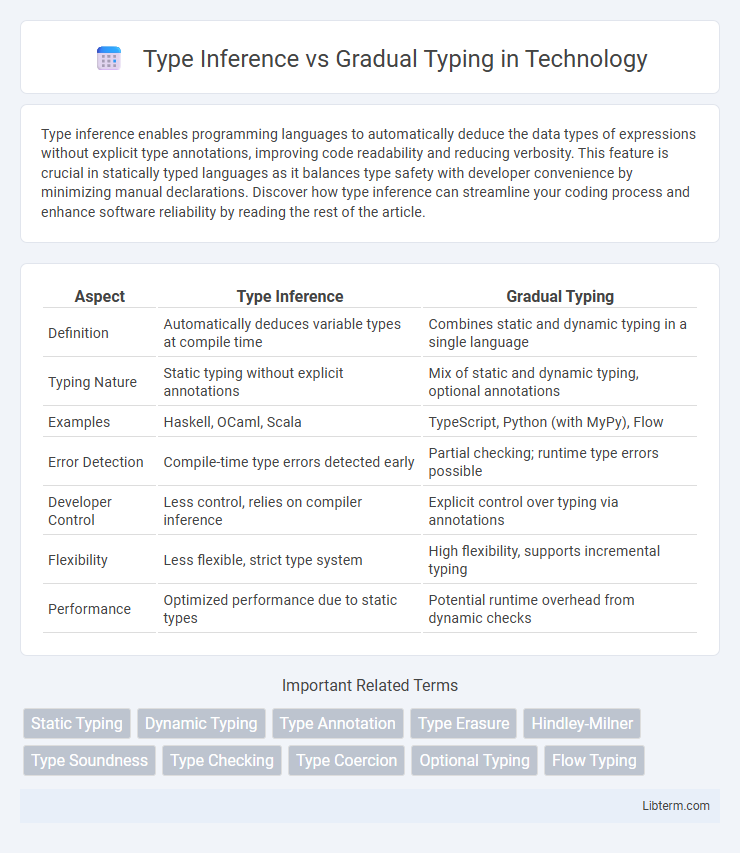Type inference enables programming languages to automatically deduce the data types of expressions without explicit type annotations, improving code readability and reducing verbosity. This feature is crucial in statically typed languages as it balances type safety with developer convenience by minimizing manual declarations. Discover how type inference can streamline your coding process and enhance software reliability by reading the rest of the article.
Table of Comparison
| Aspect | Type Inference | Gradual Typing |
|---|---|---|
| Definition | Automatically deduces variable types at compile time | Combines static and dynamic typing in a single language |
| Typing Nature | Static typing without explicit annotations | Mix of static and dynamic typing, optional annotations |
| Examples | Haskell, OCaml, Scala | TypeScript, Python (with MyPy), Flow |
| Error Detection | Compile-time type errors detected early | Partial checking; runtime type errors possible |
| Developer Control | Less control, relies on compiler inference | Explicit control over typing via annotations |
| Flexibility | Less flexible, strict type system | High flexibility, supports incremental typing |
| Performance | Optimized performance due to static types | Potential runtime overhead from dynamic checks |
Understanding Type Inference: Definition and Mechanisms
Type inference refers to the automatic deduction of variable types by a compiler or interpreter without explicit type annotations from the programmer, enhancing code readability and reducing verbosity. It operates through mechanisms such as Hindley-Milner type inference or algorithm W, which analyze program expressions to infer the most general type consistent with the program's operations. Understanding type inference involves recognizing its role in improving developer productivity and program safety by catching type errors at compile time while maintaining concise and flexible code.
Gradual Typing Explained: Features and Benefits
Gradual typing combines static and dynamic type checking, allowing developers to incrementally add type annotations to existing dynamically typed codebases. This approach enhances code reliability by enabling the compiler to catch type errors early while preserving flexibility for dynamic typing where needed. Key features include smooth interoperability between typed and untyped code, improved maintainability, and faster debugging through enhanced type safety.
Key Differences Between Type Inference and Gradual Typing
Type inference automatically deduces variable types at compile-time without explicit annotations, enhancing code brevity and reducing redundancy. Gradual typing, in contrast, allows mixing static and dynamic types within the same codebase, enabling developers to incrementally add type safety. Key differences include type inference's compile-time analysis versus gradual typing's runtime checks and flexible type annotations supporting both dynamic and static typing paradigms.
How Type Inference Improves Developer Productivity
Type inference streamlines coding by automatically deducing variable types, reducing the need for explicit type annotations and minimizing boilerplate code. This accelerates development cycles and lowers the cognitive load on developers, enabling faster prototyping and iteration. Unlike gradual typing, which introduces typing discipline incrementally, type inference provides seamless static type checking without interrupting the flow of dynamic coding practices.
Advantages of Gradual Typing in Modern Programming
Gradual typing offers a flexible approach by combining static and dynamic typing, allowing developers to incrementally add type annotations without sacrificing code agility. This balance enhances code safety by enabling early error detection in critical sections while maintaining rapid prototyping and iterative development. Popular languages like TypeScript and Python leverage gradual typing to improve maintainability and scalability in large codebases.
Language Examples: Type Inference vs Gradual Typing
Type inference, as seen in languages like Haskell and OCaml, automatically deduces variable types at compile time, enhancing code safety without explicit type annotations. Gradual typing, exemplified by TypeScript and Python with type hints, allows developers to mix dynamically typed and statically typed code, providing flexibility in type enforcement and incrementally improving code reliability. These paradigms offer distinct approaches to balancing type safety and developer productivity in modern programming languages.
Error Detection and Debugging: A Comparative Analysis
Type inference enables compilers to automatically deduce variable types, leading to earlier error detection during compile time and reducing runtime type errors, which significantly eases debugging. Gradual typing combines static and dynamic typing, allowing sections of code to be type-checked while others remain untyped, which can result in delayed error detection until runtime and more complex debugging processes. In terms of error detection and debugging efficiency, type inference offers more immediate and precise feedback, whereas gradual typing provides flexibility at the cost of potential runtime type errors.
Performance Impacts: Inference versus Gradual Typing
Type inference often leads to better runtime performance because it resolves types at compile-time, enabling aggressive optimizations and reducing runtime type checks. In contrast, gradual typing introduces runtime overhead by inserting type checks dynamically to maintain safety between statically and dynamically typed code segments. This overhead can cause slower execution, especially in performance-critical applications where frequent type validations impact overall efficiency.
Adoption Trends in Programming Languages
Type inference has gained widespread adoption in modern programming languages such as Haskell, Rust, and Swift due to its ability to reduce code verbosity while maintaining strong static typing. Gradual typing, combining dynamic and static typing features, shows increasing popularity in languages like TypeScript and Python as developers seek flexibility alongside type safety in large-scale applications. Recent surveys indicate a growing trend toward gradual typing in dynamically typed language communities, while purely statically typed languages continue to enhance type inference capabilities for developer productivity.
Choosing the Right Typing Approach for Your Project
Choosing the right typing approach depends on your project's complexity, team expertise, and long-term maintenance goals. Type inference offers the advantage of reducing boilerplate code while maintaining static type safety, making it ideal for projects prioritizing developer productivity without sacrificing reliability. Gradual typing provides flexibility by allowing a mix of dynamic and static types, which suits evolving codebases or teams transitioning from untyped to typed systems.
Type Inference Infographic

 libterm.com
libterm.com